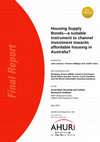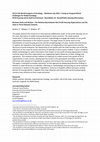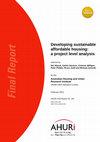Papers by Vivienne Milligan
Housing Studies, Feb 8, 2023

AHURI AHURI is a national independent research network with an expert not-for-profit research man... more AHURI AHURI is a national independent research network with an expert not-for-profit research management company, AHURI Limited, at its centre. AHURI's mission is to deliver high quality research that influences policy development and practice change to improve the housing and urban environments of all Australians. Using high quality, independent evidence and through active, managed engagement, AHURI works to inform the policies and practices of governments and the housing and urban development industries, and stimulate debate in the broader Australian community. AHURI undertakes evidence-based policy development on a range of priority policy topics that are of interest to our audience groups, including housing and labour markets, urban growth and renewal, planning and infrastructure development, housing supply and affordability, homelessness, economic productivity, and social cohesion and wellbeing. AHURI Limited also gratefully acknowledges the contributions, both financial and in-kind, of its university research partners who have helped make the completion of this material possible. The research team gratefully acknowledges the contributions of all our Australian and international interviewees, and the participants in our expert workshop, as well as Xin Xia and Alessandra Buxton (City Futures Research Centre) for their administrative support. Disclaimer The opinions in this report reflect the views of the authors and do not necessarily reflect those of AHURI Limited, its Board, its funding organisations or Inquiry Panel members. No responsibility is accepted by AHURI Limited, its Board or funders for the accuracy or omission of any statement, opinion, advice or information in this publication. AHURI journal AHURI Final Report journal series is a refereed series presenting the results of original research to a diverse readership of policy makers, researchers and practitioners. Peer review statement An objective assessment of reports published in the AHURI journal series by carefully selected experts in the field ensures that material published is of the highest quality. The AHURI journal series employs a double-blind peer review of the full report, where anonymity is strictly observed between authors and referees.
Hybridity Organisations with 'significant characteristics of more than one sector' (public, priva... more Hybridity Organisations with 'significant characteristics of more than one sector' (public, private & third) (Billis 2010) Public & private / for-profit & NFP (4 th sector?) Concerns governance & politics, org. values, ownership, structure & culture, strategy & working methods (Karre 2012) Search for synergies between state, market & civil society logics/strengths Difficult balancing act (Rubin in Bratt 2012, Blessing 2012) or impossible challenge? (Stoeker in Bratt) The 'ideal' hybrid (Karré 2012
AHURI Research and Policy Bulletin, May 29, 2012
This bulletin is based on research conducted by Professor Kath Hulse at the AHURI Swinburne-Monas... more This bulletin is based on research conducted by Professor Kath Hulse at the AHURI Swinburne-Monash Research Centre, and Associate Professor Vivienne Milligan and Dr Hazel Easthope at the AHURI UNSW-UWS Research Centre. The research examined the provisions for secure occupancy across rental systems in Australia and other similarly developed countries, and considered the potential to adapt these provisions to Australia. How can secure occupancy in rental housing be improved in Australia?

Housing Policy in Australia, 2019
This chapter examines the motivations and justifications that underlie housing policy measures or... more This chapter examines the motivations and justifications that underlie housing policy measures or ‘interventions’. The first part of the chapter discusses the classic stated reasons for government action in this sphere: measures to promote efficiency (countering ‘market failure’), to enhance equity (addressing social justice concerns) and to ensure economic stability. The application of these ideas to housing policy in Australia from the 1980s is then interpreted to show the influence of neo-liberal policy ideas. Having discussed the explanations of government intervention that stress the correction of market failure and the need to promote economic stability, the chapter goes on to review more critical perspectives on housing policy motivations and drivers, including political party ideologies, interest group politics and lobbying and a wider ‘political economy’ critique.

The aim of this study is to develop a special purpose financial instrument, identified in this re... more The aim of this study is to develop a special purpose financial instrument, identified in this report as Housing Supply Bonds, to finance the supply of affordable rental housing in Australia. While international efforts in the field of private finance for affordable housing accelerated in the 1990s, Australian policy has continued to rely heavily on government funding and sporadic innovative programs. This project investigates the potential to adapt the Austrian Housing Construction Convertible Bonds scheme to Australia. The Austrian scheme has been found to be popular among risk averse investors, an efficient scheme for capturing long-term savings, and given the modest tax incentive, very cost effective. The project presents a well-grounded concept for an Australian Housing Supply Bond that would be issued by a specialised financial intermediary, and regulatory measures that are designed to ensure that the funds raised through bond issues are channeled towards affordable rental hou...

This paper presents the results of an international collaborative study5 of non-profit housing; o... more This paper presents the results of an international collaborative study5 of non-profit housing; one of the main alternatives to public housing developed in many countries. The study involved researchers6 in three countries using a common methodology to engage the leaders of non-profit organisations themselves in the research process. The paper draws on earlier work on the hybridisation of social housing provision and the competing logics of state, market and third sector. It explores the hypothesis that despite the rhetoric of independence from government and the discourse of social enterprise, the relationship of non-profits with the state has been one of the key influences on the scope for action and forms of hybridity in each country studied. It uses a modified Delphi methodology to collect information from leaders of non-profit housing organisations in three countries about how their organisations are negotiating hybrid influences on their strategy and operations. This method in...
International Journal of Housing Policy, 2018
This study provides a review of housing policies across an array of countries that have a similar... more This study provides a review of housing policies across an array of countries that have a similar level of economic development to that of Australia but have addressed housing questions in different ways. It aims to increase local understanding of international policy in housing, with a focus on social policies that intend to assist lower-income households to obtain appropriate and affordable housing, and to promote good ideas for policy action for consideration by Australian policy makers.

AHURI comprises a network of universities clustered into Research Centres across Australia. Resea... more AHURI comprises a network of universities clustered into Research Centres across Australia. Research Centre contributions, both financial and in-kind, have made the completion of this report possible. The authors would especially like to thank those eight not-for-profit housing developers whose projects are examined in this study. Research of this kind would not be possible without their full support. The authors are also particularly grateful to Michael Zanardo (University of Sydney) whose expertise in affordable housing design has enriched the study. Helpful comments were also received from two academic reviewers. DISCLAIMER AHURI Limited is an independent, non-political body which has supported this project as part of its programme of research into housing and urban development, which it hopes will be of value to policy-makers, researchers, industry and communities. The opinions in this publication reflect the views of the authors and do not necessarily reflect those of AHURI Limited, its Board or its funding organisations. No responsibility is accepted by AHURI Limited or its Board or its funders for the accuracy or omission of any statement, opinion, advice or information in this publication. AHURI FINAL REPORT SERIES AHURI Final Reports is a refereed series presenting the results of original research to a diverse readership of policy-makers, researchers and practitioners. PEER REVIEW STATEMENT An objective assessment of all reports published in the AHURI Final Report Series by carefully selected experts in the field ensures that material of the highest quality is published. The AHURI Final Report Series employs a double-blind peer review of the full Final Report-where anonymity is strictly observed between authors and referees. iii CONTENTS LIST OF TABLES .

Description This project looked at transfers in three jurisdictions (New South Wales, Tasmania an... more Description This project looked at transfers in three jurisdictions (New South Wales, Tasmania and Victoria) and involved in-depth interviews with stakeholders and focus groups with former public housing tenants that transferred to not-for-profit landlords. Between 1995 and 2012, 21 279 dwellings were transferred. About half of these (10 828) occurred after 2010 under the Social Housing Initiative. Transfers planned to occur by the end of 2014 in Queensland, South Australia and Tasmania could add up to 10 000 more properties under community housing provider management. Transfers have tended to be management outsourcing (rather than asset handovers), reflecting concerns by treasuries to maintain assets on balance sheets. Most have been to existing providers, involved competitive processes for landlord selection, and management outsourcing often involve three- to five- year contract terms, though longer terms are being contemplated in some states. The motivations for public housing transfers has been: community housing sector development (with the aim that 35% of all social housing is in the sector by 2014); revenue maximisation (enabling providers to access revenue from tenant Commonwealth Rent Assistance payments); leveraging finance for growth of the community housing sector; service improvement; tenant empowerment and community renewal. The study found evidence of some progress across most of these areas, though less so for tenant empowerment. With the exception of transfers from Aboriginal Housing Victoria, public housing transfer proposals in Australia have tended to involve only a very limited amount of prior tenant or community consultation, due to short time frames for program implementation and competitive processes for selection of landlords. Individuals can choose to remain a public tenant, but may find their existing property under new management. This has undermined effective choice, and proved managerially inefficient. Even so, most tenants (sometimes up to 90%) have switched landlords. More widespread stock transfers would require a different approach to the ‘pilot’ transfers already undertaken. This might involve less tenant choice but increased tenant consultation, changed arrangements for staffing and landlord succession, and agreed minimum standards for properties upon transfer. Transfer has also highlighted the need for greater clarity over the social policy objectives of social housing (affecting tenant profiles and incomes), rent setting policies and resourcing for maintaining properties to ensure sustainability over the long term.

Research background and aims BtR precedents The BtR concept: Australian interpretations and their... more Research background and aims BtR precedents The BtR concept: Australian interpretations and their feasibility Modelling BtR financial feasibility within existing taxation policy settings Policy levers BtR and affordable housing The future 1. Introduction 1.1 Research origins and objectives 1.2 Policy and housing market context 1.3 Research methods 1.4 Report structure 30 2. The Emergence of build-to-rent in Australia 30 2.1 Chapter overview 30 2.2 Multifamily and build-to-rent housing in the USA and the UK 37 2.3 Australian BtR antecedents 44 2.4 Drivers of growing BtR interest in Australia 47 2.5 Chapter summary 48 3. The BtR concept: Australian interpretations and their feasibility 48 3.1 Key players and institutions in BtR development, finance and management 53 3.2 BtR business models 55 3.3 Locations and built forms 57 3.4 Target markets and service offer 58 3.5 Modelling five types of Australian BtR 71 3.6 Chapter summary Build-to-rent in Australia: Product feasibility and potential affordable housing contribution 106 6.1 Revisiting the research questions 110 6.2 Implications for Landcom 112 Appendix 1: modelling assumptions, sources and method 112 Development costs 112 Operating costs and revenues 113 Development and operating phase rates of return 114 References Contents 5 List of figures 7 Grocon-Parklands, Gold Coast, Qld Executive Summary Key findings • Coinciding with shifts in international investment markets, developments in Australia's demographic profile and 'residential consumer' sentiment have recently combined to enhance the prospects for the emergence of a 'mainstream market' Build-to-Rent (BtR) sector
Housing Policy in Australia, 2019
Around one in every four Australians rent their home from a private landlord. The past two decade... more Around one in every four Australians rent their home from a private landlord. The past two decades have seen strong growth in the private rental sector and a rising incidence of long-term (perhaps perpetual) renting, especially among younger and less affluent Australians. This chapter first describes the structure and institutions of Australia’s rental market, the private rental dwelling stock, and the sector’s residents. Tax and other policy settings affecting the form and level of private rental property investment are then explained. The focus then shifts to regulatory policy affecting the consumer experience of private rental and forms of government financial support to low-income renters. In view of the sector’s evolving significance, options for reform of present tax and regulatory policy settings are debated throughout.
leadership, strategy and organisational dynamics in the not-for-profit housing sector authored by

This chapter examines government-led responses to the intensifying shortage of affordable housing... more This chapter examines government-led responses to the intensifying shortage of affordable housing. The emphasis is on endeavours to enable low cost (below-market) rental housing development using public subsidies and other incentives to leverage private investment, alongside adoption of new institutional and governance arrangements for affordable housing services. The chapter explains the operating principles of the affordable housing business model, including the role of public subsidy to meet the gap in funding between required investor returns and revenue based on affordable rents. International approaches to public–private co-financing are showcased, followed by an interpretation of potential lessons for Australia. The current status of Australian efforts to adopt new investment models and an analysis of the main domestic barriers to private institutional investment in affordable housing are also included.
AHURI Research and Policy Bulletin, 2015
This bulletin is based on research conducted by Professor Hal Pawson, Associate Professor Vivienn... more This bulletin is based on research conducted by Professor Hal Pawson, Associate Professor Vivienne Milligan and Dr Ilan Wiesel at the AHURI Research Centre— University of NSW, and Professor Kath Hulse at the AHURI Research Centre—Swinburne University of Technology. The research examined previous transfers of existing public housing to community housing providers in Australia in order to inform objectives and operational framework for large-scale future transfers. Public stock transfers to community housing the best option for a sustainable and financially supportable housing system
AHURI Research and Policy Bulletin, 2008
Recent AustRAliAn policy settings hAve been lARgely unResponsive to emeRging housing chAllenges, ... more Recent AustRAliAn policy settings hAve been lARgely unResponsive to emeRging housing chAllenges, such As tRends to declining AffoRdAbility And the gReAteR polARisAtion of housing mARkets. While the scope And mix of policy leveRs RequiRed to AddRess these issues in AustRAliA mAy vARy, this ReseARch suggests thAt theRe ARe common AttRibutes AssociAted With the most successful policy AppRoAches oveRseAs.
The success of any international review rests on the quality of reference material and the contri... more The success of any international review rests on the quality of reference material and the contribution of key local experts. We are grateful for the work of various researchers and policy makers, for those who have brought together comparative material on financing approaches in Europe and the US and also the pioneering research undertaken by Australian researchers concerning the development of affordable financing mechanisms drawing on international strategies. Particular thanks are due to Mark Washer,
This report provides an overview of the major findings that have emerged out of the third AHURI-f... more This report provides an overview of the major findings that have emerged out of the third AHURI-funded National Research Venture (NRV3), Housing affordability for lower income Australians. It identifies the major risks and challenges in relation to Australia's ...











Uploads
Papers by Vivienne Milligan